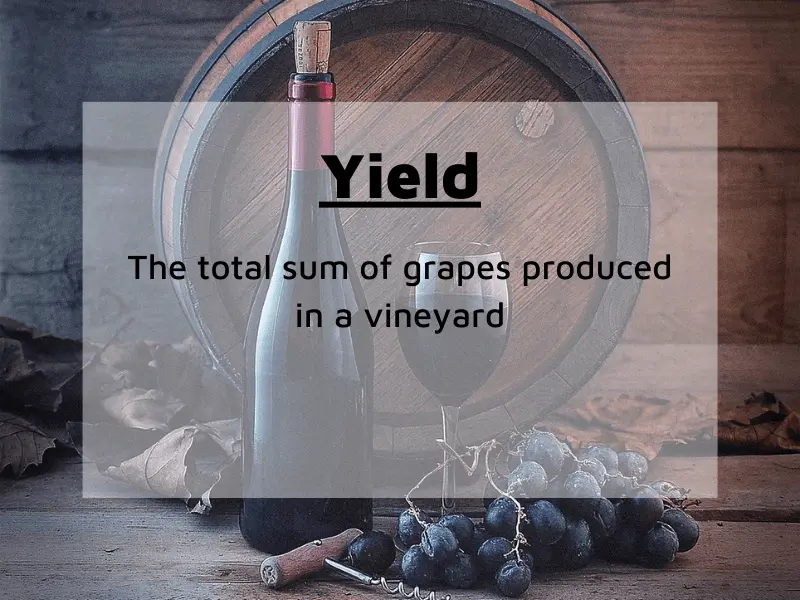Wine terms | Glossary
When talking about wine, one might be confused by the terminology and french words, which are sometimes hard to understand. Wine is a complex and diverse beverage with long history. Some winery words and terms can be special and you can even take classes for them, but it’s probably enough that you learn a few basic terms and you will sound like a pro.
We put together a huge list of all important wine terms, basically a wine terminology glossary that should get you sounding like a pro on your next wine tasting.
This wine terms dictionary serves as a reference for wine enthusiasts, providing definitions and explanations of common wine terminology.
You will get to know the definitions for terms related to wine production, descriptions of the different types of wine, as well as terms describing the taste, appearance and aroma of wine.
Wine terms starting with A
- ABC: Term by winemaker Randall Grahm, that means Anything but Chardonnay or Anything but Cabernet.
- Acidity: A component of every wine, that can be perceived as crisp or fresh. It creates a balance between sweet and bitter. We know citric, tartaric, malic, and lactic acids.
- Aeration: The intended addition of oxygen to the wine, to enhance the flavor.
- Aftertaste: The taste that strays in the mouth after tasting wine, another term for finish.
- Aged: Wine that has been preserved in adequate conditions for a longer time period and gets better with time.
- Aging: The process of storing wine in barrels, tanks, or bottles in a controlled condition for a longer duration, so it can develop complexity.
- Aging barrel: A barrel, usually made of oak, where they age wines or spirits.
- Alcohol by volume (ABV): The alcohol levels described in percentage on a wine label. The average bottle of wine has between 9% and 16% alcohol.
- Alcohol: In wine, we find ethanol, which is produced by the fermentation of sugars found in grapes.
- Alsace: A wine region in eastern France, known for dry and sweet wines.
- Amarone: Red wine with higher alcohol levels, that comes from the Italian region Veneto.
- Anosmia: Lost sense of smell.
- AOC: Abbreviation for french laws Appellation d’Origine Contrôlée, which translates to Appellation of controlled origin. It specifies and delimits the geography a wine comes from.
- Aperitif: A wine that is usually drunk by itself before a meal.
- Appellation: A defined geographical region where grapes are produced for the wine. You can also see a similar french abbreviation AOC (Appellation d’Origine Contrôlée), which is the french government certification for agriculture products, that come from a certain region.
- Aroma: The smell of wine. The term is usually used when speaking about younger wines, for aged wines the term is Bouquet. When we talk about aroma we use different scents, like fruit or floral.
- Astringency: Drying or bitter feeling in your mouth, that is caused by tannins.
- AVA: Abbreviation for American Viticultural Area. It is a wine region approved by the Bureau of Alcohol, Tobacco, and Firearms.
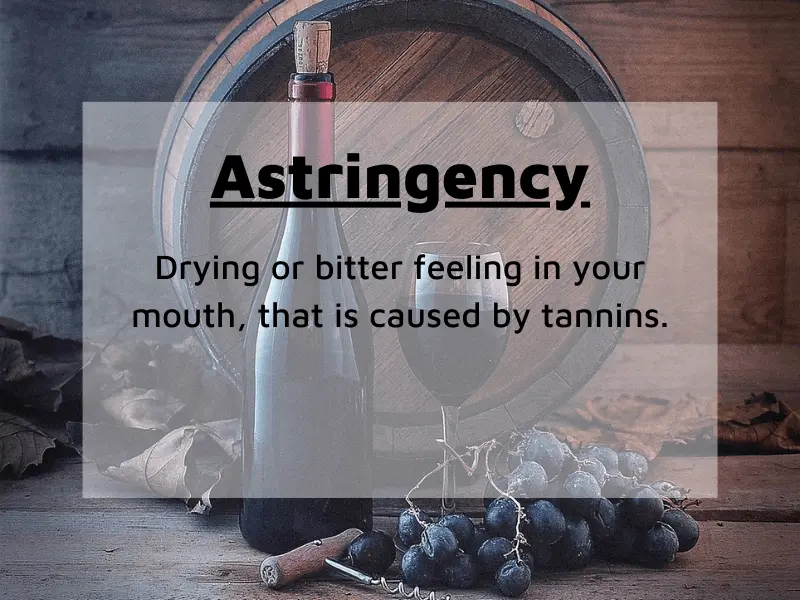
Wine terms starting with B
- Bacchus: Roman god of winemaking, in ancient Greece known as Dionysus.
- Bacterial spoilage: Unwanted bacteria that can cause off-flavors and aromas or even deterioration.
- Balance: When wine’s elements, such as acidity, tannins, sweetness, and alcohol, are harmonious.
- Balthazar: A 12-liter bottle.
- Ban de Vendange: The start of the harvest in France.
- Barrel: Container made out of oak for fermenting and aging wine.
- Barrel fermentation: When wines are fermented in oak barrels and not in tanks. Wines fermented in barrels have a richer style.
- Barrique: French term for barrel, usually with a capacity of 225 liters.
- Baumé: Similar to ABV, a measure of how much sugar there is in grape juice.
- Beaujolais: Red wine made from Gamay grapes.
- Beaujolais Nouveau: The first Beaujolais of the harvest.
- Bentonite: Clay that winemakers use in the process of clarification.
- Bin: Storage container or location in a cellar where wine is stored. Also used in the names of some wines.
- Biodynamic Wine: Wine that is produced by Biodynamic guidelines, which follows holistic, ecological, and ethical pathways, where no synthetic chemicals are allowed.
- Bitter: A taste in the back of the tongue, that is caused by tannins.
- Blanc de Blancs: A term for Champagne made from Chardonnay grapes.
- Blanc de Noirs: A term from Champagne made from red grapes Pinot Noir or Pinot Meunier.
- Blending: The process of combining two or more grape varietals or wines to produce a new wine.
- Blind tasting: Process of tasting and assessing wines without knowing what it is.
- Blush: Wine made from red grapes, but the grape skin is removed during fermentation, so the wine is pink, also known as rosé wine.
- Bodega: Spanish term for a winery.
- Body: The sensation describing the feel and weight of a wine in the mouth, it can feel heavy or thin. We distinguish between light, medium, and heavy-bodied wines.
- Bordeaux: A wine region in Southwest France.
- Botrytis cinerea: A beneficial mold known as noble rot, that causes the sugars in the grapes to concentrate, resulting in sweeter wines.
- Bottle: Glass container, where the neck is narrower than the body.
- Bottle Age: Before being opened quality wines are usually aged in bottles to mature, this can take 20 or more years.
- Bottle shock: A temporary condition of muted fruit flavors, that occurs after bottling or when bottles are shaken.
- Bottle variation: The variation of bottles of wine from the same style and vintage.
- Bouquet: The complex smell of mature wine. These aromas develop during the aging process.
- Box wine: Wine packed in a bag, that is protected by a cardboard box.
- Breathing: Another term for aeration. Deliberate exposing the wine to oxygen to enhance the flavors.
- Berettanomyces: A yeast that spoils the wine, it causes barnyard-like aromas.
- Bright: Wine that is very clear and has almost no suspended solids.
- Brilliant: A sparkling clear taste in wines.
- Brix: A standardized scale to measure sugar content in grapes, that allows prediction of future alcohol content.
- Brut: French term describing dry sparkling wines.
- Bung: Another term for corks, a plug with which you seal a wine barrel.
- Bunghole: The opening through which a cask can be filled with wine or emptied.
- Burgundy: A wine region in eastern France.
- Butt: An English unit equated to 108 imperial gallons or 491 liters.
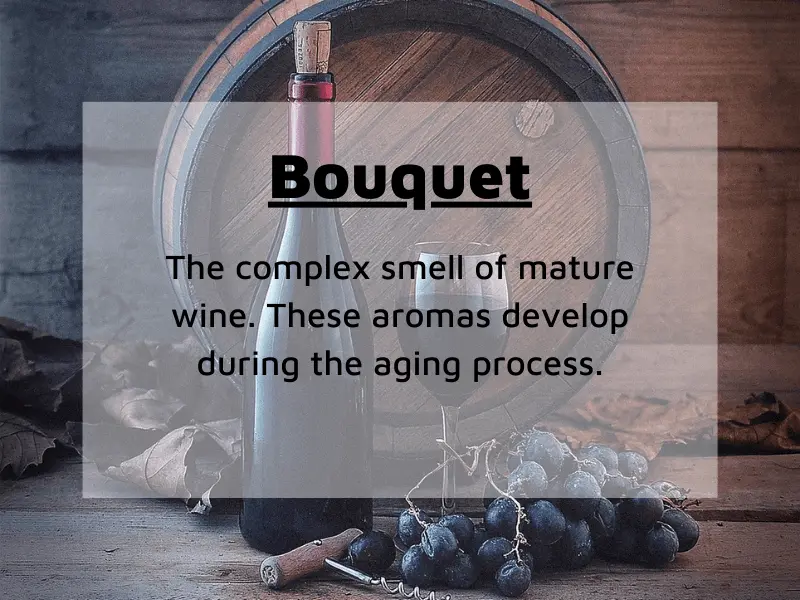
Wine terms starting with C
- Cabernet Franc: A red grape that is common in Bordeaux.
- Cabernet Sauvignon: A very well-known red grape, from which many great red wines are made from.
- California cult wines: Wines from California that can be sold at a higher price.
- Cane pruning: A pruning method in which you cut the vine down to a cane or more, and they will, later on, produce new shoots.
- Canopy: Shoots and leaves of the vine.
- Cantina: Italian word for a winery.
- Cap: Solids like grape skin, seeds, and stems that accumulate on top of a fermenting tank during fermentation.
- Capsule: The plastic or foil protective cover on the neck of a wine bottle.
- Carbon dioxide: Bubbles in wine, that are a byproduct of fermentation.
- Carbonic Maceration: A winemaking technique that results in softer, fruity wines with little tannin. The process includes fermenting whole grapes in a sealed tank, which is filled with carbonic gas.
- Cask: A wood barrel used for fermentation or aging.
- Caudalie: How long can you feel the wine’s finish in seconds.
- Cava: Spanish sparkling wine.
- Chablis: A French wine region east of Paris.
- Cellar: A place to store wine, where the temperature and humidity are controlled.
- Champagne: Sparkling wine made in the French region Champagne.
- Champagne flute: A type of glass with a long stem and narrow bowl, meant for serving champagne.
- Chaptalization: The process of adding sugar before or during fermentation to increase the alcohol content.
- Chardonnay: A wine grape used for making Chardonnay, Champagne, and other white wines.
- Charmant process: Process for making sparkling wine, when they go through secondary fermentation in tanks and not in bottles.
- Chenin Blanc: A type of white grape, often grown in French Loire Valley.
- Chianti: A part of the Italian region Tuscany, known for red wines.
- Chiaretto: Italian word for a pale rosé.
- Citric Acid: One of the acids in wine.
- Clairet: French word for wines that are between light red and dark rosé.
- Claret: English word for red Bordeaux wines.
- Clarification: A winemaking process of removing solid parts from wine after fermentation to make it clear.
- Clarifying agent: A substance added to wine during the clarification process to help remove solid particles.
- Clarity: How transparent or clear a wine is.
- Cleanskin: Term used in Australia for wines sold cheaply in bulk and without commercial labels.
- Clos: French term for walled vineyards.
- Closed: Wines, usually young wines, that have not yet developed their full potential, so the flavors are not very distinct.
- Cold duck: A drink made from equal parts of red wine and sparkling wine.
- Cold fermentation: Type of fermentation in cooled tanks. Because the process is slow it results in more fruity aromas and flavors in wine.
- Cold Soak: Vinification technique in which crushed grapes are held in a cold environment for some time before fermentation.
- Cold stabilization: Process in winemaking in which wine is chilled to near freezing point to get tartrate crystals out of wine, which makes the wine clearer.
- Color: One of the convincing factors of wine’s quality and also age, since wines change color as they age.
- Complex: A wine that has countless scents and aromas, is considered an important quality.
- Cooperative: Organization that is owned by many winegrowers, who produce under one label.
- Cordon training: Also known as spur pruning, when the trunk of a vine extends horizontally and grapes grow for many years.
- Cork taint: Unwanted aromas associated with mold, usually coming from a contaminant cork.
- Corkage: The fee a customer must pay if they bring wine to a restaurant and want it to be served.
- Corked: Flawed wine, that smells musty and is ruined because of a contaminant cork usually with TCA.
- Corkscrew: A device to take out the wine cork.
- Country wine: A wine that’s better quality than table wine, but lower than quality wine.
- Crackling: Also known as frizzante, slightly sparkling wine.
- Crémant: French fizzy wine, that is not made in Champagne.
- Crianza: Spanish word for aged red wine. It must be aged in a barrel for at least a year and at least another year in the bottle.
- Crown cap: Form of a bottle cap.
- Cru: A French term meaning growth, that indicates high-quality vineyards.
- Crush: Term for the beginning of harvest.
- Cult wine: Wines that are highly sought after and rare, and buyers are prepared to pay a lot of money for them.
- Cuvaison: A term for the time wine is in contact with solid particles during fermentation.
- Cuvée: A blended lot of wine.
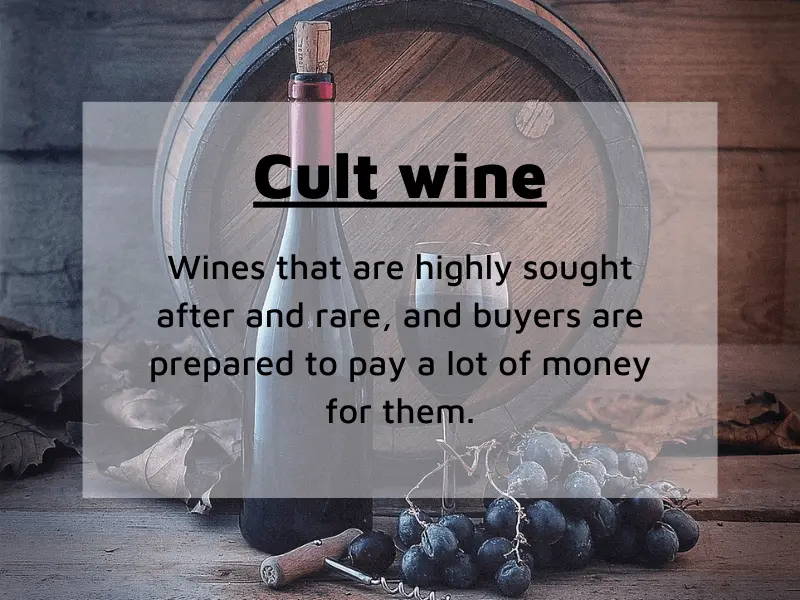
Wine terms starting with D
- Débourbage: A winemaking process where the must in white wine is settled before racking, so there is less need for filtration.
- Decanting: Pouring wine from a bottle into a container, you can use a decanter or an everyday pitcher. Decanting is done to remove any sediment or to allow the wine to aerate.
- Degorgement: The process during sparkling wine production of removing the frozen plug containing spent yeast from the neck of a bottle.
- Dégorgement tardive: French for a Champagne that was aged on lees for 10 and more years before the process of degorgement.
- Demi-sec: Another term for half-dry.
- Dessert wine: Wines that are high in alcohol and very sweet, usually served with dessert.
- Distilled spirits: Alcoholic beverages that are produced by distillation from wine, other fermented juice, or grains that have been brewed.
- Dosage: A sweet spirit that is added to traditionally made sparkling wines. The quantity of the spirit determines how dry the wine is.
- Douro: A wine region in Portugal known for Port wines.
- Dry: Wines where there is almost no residual sugar, they are the opposite of sweet and can lead to a puckering sensation in the mouth.
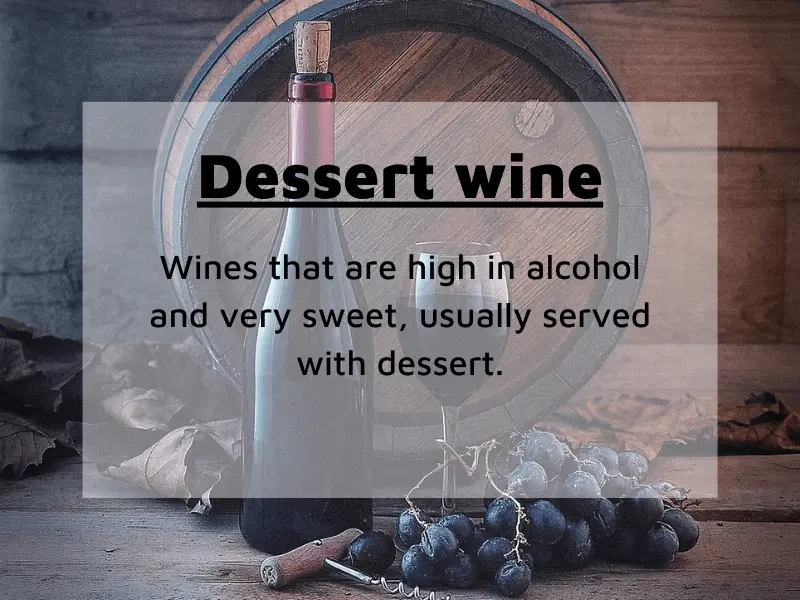
Wine terms starting with E
- Earthy: A term that describes soil-like flavor.
- Eau de vie: French term for a spirit made out of grapes.
- En primeur: System of selling wine, mostly Bordeaux wine, where contract sales are available before the wine is bottled.
- En Tirage: Part of Méthode Champenoise, where sparkling wine rests together with lees during secondary fermentation.
- Enology: The science of winemaking, also known as oenology.
- Enophile: A person who enjoys and appreciates wine.
- Entry-level wine: The cheapest wine with basic qualities a winemaker sells.
- Eraflage: French word for destemming, when the grapes are removed from the stems.
- Extended maceration: A winemaking process of allowing grape skins and seeds to remain in contact with the juice or wine for a prolonged period. The process enables the extraction of more color, flavors, and tannins.
- Extraction: Winemaking process of extracting the flavor, tannins, and color from grape skins.
- Ex-cellars: The shipping and other costs allied with selling wines en primeur.
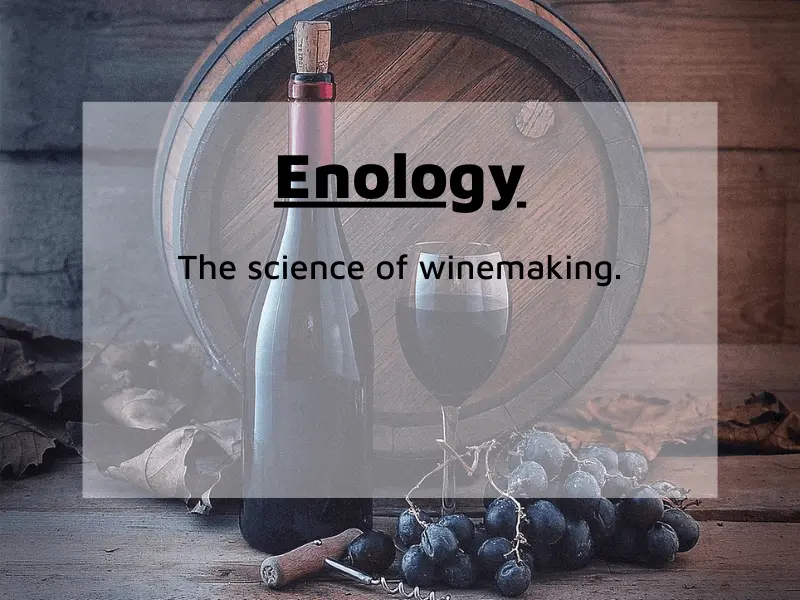
Wine terms starting with F
- Fault: When a wine has a disagreeable characteristic, it may occur because of a mistake during winemaking or storage.
- Fermentation: The process of converting sugar into alcohol and carbon dioxide, in winemaking yeast turns grape juice into wine.
- Fermentazione naturale: Italian for naturally sparkling wine, where bubbles are achieved in the bottle.
- Fermenter: A container, usually a stainless steel tank or a barrel, used for fermentation.
- Fiasco: A flask, that is covered with straws.
- Fighting varietal: American term from California, that describes inexpensive varietal wine with a cork finish in a 1.5-liter bottle.
- Filtering: The process of clarifying wine before bottling by removing solid particles.
- Fine wine: The best quality wine.
- Fining: Part of the clarification process in which a clarifying agent is added to wine to remove impurities.
- Finish: Similar to the end note, the taste, and impression that remains in the mouth after swallowing the wine.
- Flabby: A wine without structure.
- Flavors: How wine is perceived in the mouth.
- Flying winemaker: A winemaker who travels and shares winemaking skills from one region of the world to another.
- Fortification: Winemaking process in which distilled spirits are added to a wine to increase its alcohol content.
- Fortified Wine: A wine that went through fortification, which means that spirits have been added to it to raise the alcohol levels and prevent fermentation.
- Foxy: A wine-tasting term similar to mold.
- Free-run juice: Grape juice that is extracted from the fruit before pressing.
- Fruity: When the wine smells and has a flavor similar to fresh fruit.
- Fruity wine: Fermented alcoholic beverage made from other fruits than grapes.
- Full-bodied: How heavy a wine feels in the mouth, full-bodied wines feel thick.
- Fumé Blanc: Another name for a dry Sauvignon Blanc, the term was coined by Robert Mondavi.
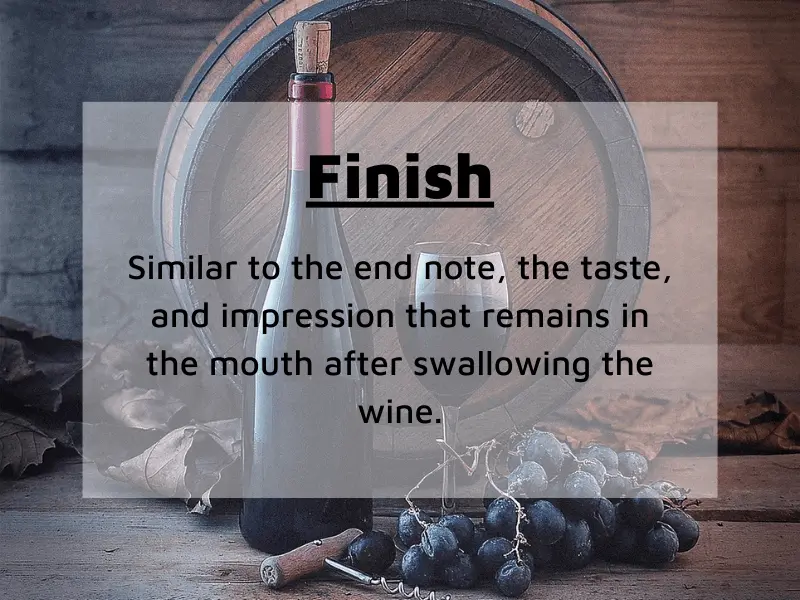
Wine terms starting with G
- Gamay: A red grape variety.
- Gewürztraminer: A sweet white grape variety.
- Globalization of wine: The fact that the wine industry has become global.
- Grafting: A vineyard technique of attaching the bud-producing part of a grapevine to an existing root.
- Grand Reserva: Spanish for wines that have been aged for at least five years.
- Grand Cru: French term describing the best vineyards.
- Granvas: Spanish term for second fermentation of sparkling wines, that happens in the tanks and not bottles.
- Green: A term that describes vegetal and underripe flavors in wine. This is not a good characteristic.
- Green harvest: The process of removing unripe grapes from the vines, which is supposed to increase the quality of the remaining grapes.
- Grenache: A type of red grape.
- Grüner Veltliner: A type of white grape.
Wine terms starting with H
- Habillage: French term for capsule, the foil or wire cork that is over the top part of sparkling wine bottles.
- Hard: When a wine has too many tannins and becomes unpleasant.
- Harvest: When grapes are picked from the vineyard.
- Haut: French word describing high quality.
- Herbaceous: A flavor that resembles fresh herbs.
- Hogshead: A 239 liters barrel.
- Hollow: A wine that has no body.
- Horizontal wine tasting: Wine tasting with wines from the same year or same style.
- Horse blanket: A wine with a barnyard-like aroma, that is caused by Brettanomyces, a type of yeast.
- Hot: Wine that has high alcohol levels.
- Hybrid: A cross of two or more grape varieties.
Wine terms starting with I
- Ice wine: A type of wine made from frozen grapes.
- Imperial: A 6-liter bottle.
- Inoculation: The addition of yeast into must to start fermentation.
- International variety: Grape varieties that grow in almost every wine region, like Merlot or Chardonnay.
Wine terms starting with J
- Jeroboam: A 4.5-liter bottle.
Wine terms starting with K
- Kabinett: The German word for best quality wines.
- Kosher: When wine is made following Jewish rules of wine production.
Wine terms starting with L
- Labrusca: Grape varieties that are endemic to North America.
- Late harvest: When grapes are left on vines for a long time, usually until noble rot has emerged. Late harvest is used for dessert wines.
- Lees aging: A winemaking technique also known as sur lie, where the wine is aged on spent yeast and other material.
- Lees: The by-product of fermentation, the sediment of spent yeast cells and grape solids.
- Legs: How wine stays on the inside of a glass after swirling.
- Length: How long does the flavor stay in the mouth after swallowing.
- Lightstruck: When a wine has been exposed to UV light, which results in a wet cardboard-like flavor.
- Liqueur de tirage: French word for a liquid solution of sugar and yeast that affects the secondary fermentation in the bottle.
- Liqueur d’expedition: French term for a liquid that is sometimes added to a sparkling wine after disgorging to make it sweeter and to top it up.
- Loire: A French wine region along the river of the same name.
Wine terms starting with M
- Maceration: Leaving grape juice together with skins, stalks, and seeds, which affects the extraction of the color, tannins, and flavor.
- Madeira: A fortified wine from the Portuguese island Madeira.
- Maderized: Oxidization of wine in a hot environment.
- Magnum: A 1.5-liter bottle.
- Malbec: A type of red grape, widespread in Argentina.
- Malic acid: One of the prevailing acids in wine.
- Malolactic bacteria: Microorganisms in wine that convert malic acid to lactic acid to make the wine softer.
- Malolactic Fermentation: The process in which malic acids in wine are transformed into lactic acids to create a more buttery flavor, can be part of secondary fermentation.
- Manipulant: French word for a vigneron who doesn’t only cultivate the grapes but also makes their wine.
- Marc: Can mean pomace, but it’s also a distillate made from pomace.
- Maturation: The process of aging wine, that improves wine’s quality.
- Mature: Wine that has gone through the maturation process and is ready to drink.
- May wine: Light wine, typical for Germany, that has a sweet and fruity flavor.
- Mead: An alcoholic drink made from fermented honey and water.
- Meritage: Blended wine, known as American Bordeaux.
- Merlot: Black wine grape, also a wine made from this vine.
- Methuselah: A 6-liter bottle.
- Micro oxygenation: A winemaking process in which small amounts of oxygen are added to the wine to reduce bitterness.
- Mid-palate: How the wine’s flavor is perceived when it’s still in the mouth.
- Mousse: How bubbles are acting in sparkling wine when poured into the glass.
- Mousseux: French word for sparkling wine.
- Mouth-feel: How wine is perceived in the mouth, smooth, velvety, rough, or furry.:
- Mulled wine: A wine that has been heated and has different spices in it.
- Must weight: A measure of the sugar in must, which can indicate the potential alcohol content in the wine.
- Must: Unfermented grape juice together with seeds, stems, and skins.
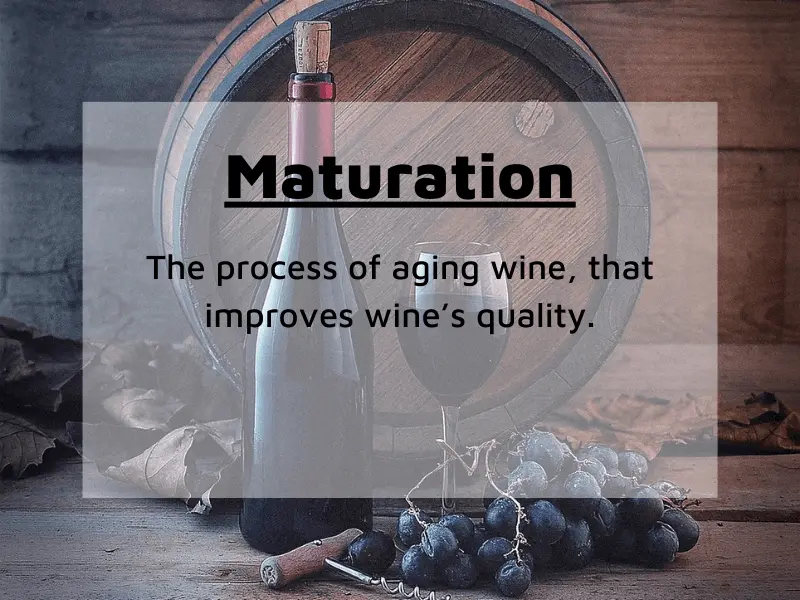
Wine terms starting with N
- Natural Wine: A wine to which nothing artificial has been added to it.
- Nebbiolo: A red grape variety, popular in the Italian region Piedmont.
- Negociant: French term for a wine trader.
- New world wine: Wine that was made in non-traditional European winegrowing regions, such as Africa or Australia.
- Noble rot: A good type of mold known as botrytis, that makes the wine sweeter.
- Nose: Another term for aroma, the smell of wine in the glass.
Wine terms starting with O
- Oak chips: Small pieces of oak, that can be added to wine and are seen as an economical alternative to barrel aging,
- Oaky: Woody aromas and flavors in the wine that develops during maturation in oak barrels or by adding oak chips.
- Oenophile: Winelover, also called vinophile.
- Off-dry: A wine that is slightly sweet.
- Old vine: Wines made from very old vines.
- Old world wine: Wine made in traditional winegrowing regions in Europe.
- Open: A wine that is ready to drink.
- Organic Wine: Wines made with grapes that were cultivated without any pesticides or synthetic ingredients.
- Organoleptic: Tasting term, describing anything that affects smell, taste, and sight.
- Oxidation: When wine is exposed to oxygen, which can negatively impact the wine.
- Oxidized: A wine exposed to too much air and has become flat and brownish.
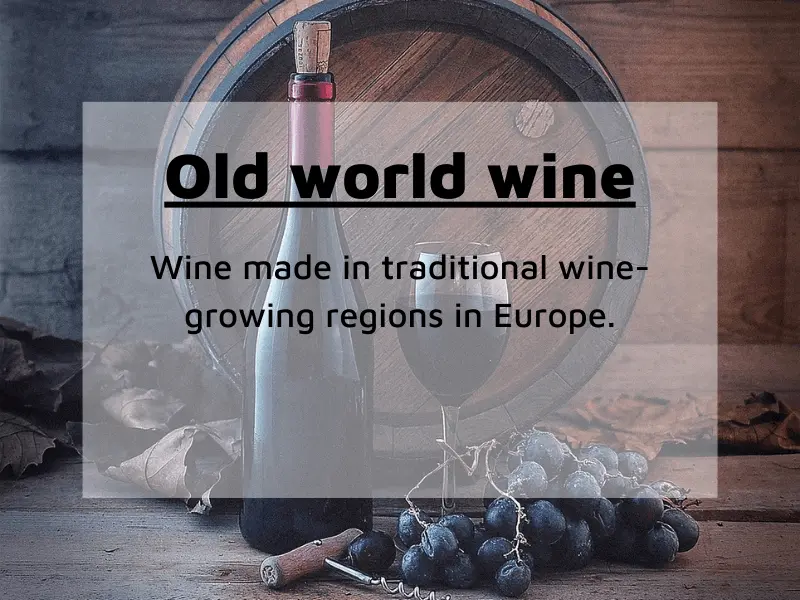
Wine terms starting with P
- pH: Indicator of wine’s acidity.
- Phenolics: Important compounds produced from parts of the grapes that contribute to flavor and color in wine.
- Phylloxera: A insect that attacks the roots of grape vines.
- Piedmont: An Italian region.
- Pinot: Black or white grape variety from which Pinot Noir and Pinot Grigio are made.
- Pinotage: A hybrid vine between Cinsault and Pinot Noir.
- Pip: Term for grape seeds.
- Plonk: British slang for cheap and low-quality wines.
- Pomace: Grape skins, seeds, and stems that are left after fermentation.
- Port: A Portuguese fortified wine made in Douro Valley.
- Potassium sorbate: A preservative and stabilizer for wines.
- Premier Cru: A high-quality vineyard, but still lover quality than Grand Cru.
- Premium wines: Higher quality wines, better than table wines, that can be very expensive and have more aging potential.
- Pressing: The process in which juice is extracted from grapes using a wine press before fermentation.
- Primary aromas: The aromas in wine that come from the grapes themselves and are part of the grape variety.
- Primeur: French word for wine that is still in the barrels when sold.
- Pruning: Trimming grape vines after harvesting.
- Punching down: The process of manually submerging the cap of skins and solids into the must during fermentation to prevent drying out and to extract color and tannins.
- Punt: It’s the dent at the bottom of a glass bottle.
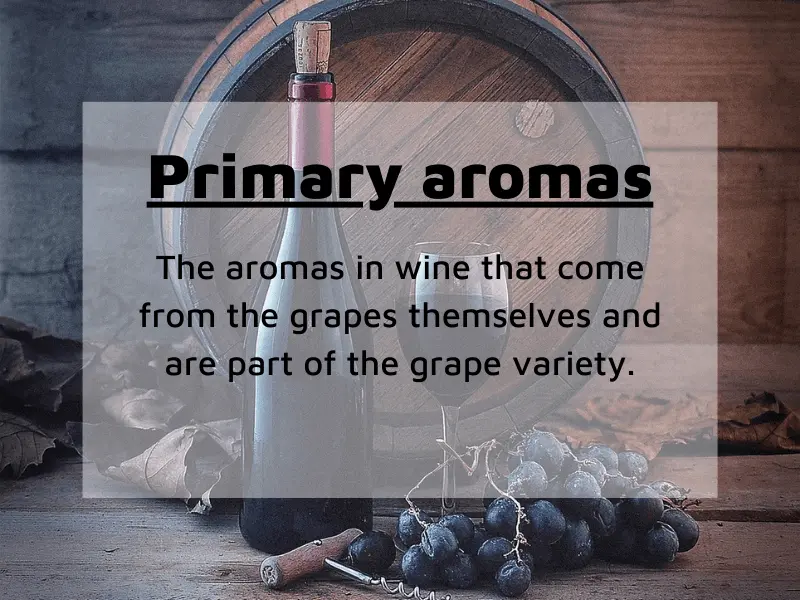
Wine terms starting with R
- Racking: The process of moving the wine from one container to another, so the sediment is removed.
- Recioto: A sweet wine from Italy.
- Reductive: Winemaking practice in which they limit the amount of oxygen the wine is exposed to.
- Red Wine: Type of wine that is made from red or black grapes, where grape juice is fermented together with the grape skin.
- Reserva: Spanish word for a red wine that has been aged for at least three years.
- Residual sugar: The unfermented sugar remaining in a wine.
- Riddling: The procedure of turning bottles of Champagne so the sediments move towards the cork.
- Riesling: A white grape variety.
- Rioja: A Spanish wine region, also wine with the same name.
- Rosé: Wine with a pink hue, made from red grapes.
- Rough: A term describing sensation in the mouth, usually from acetic or bitter wines.
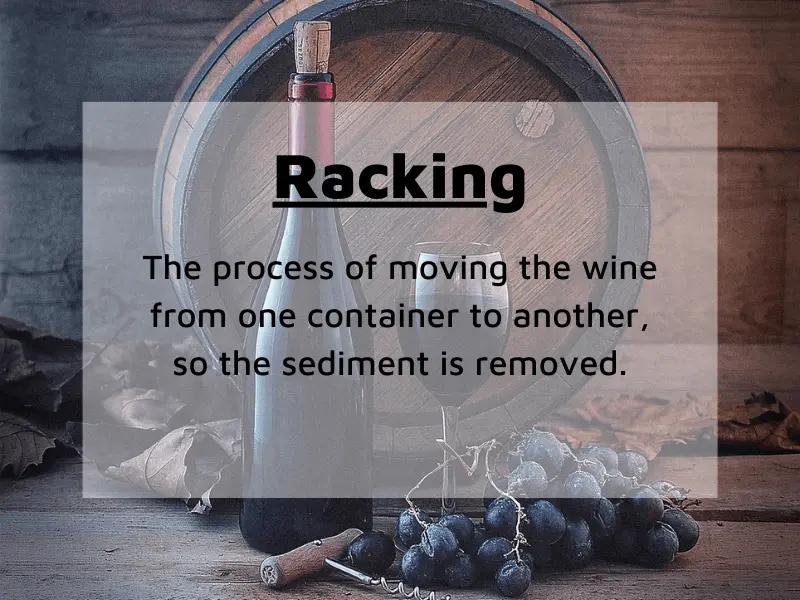
Wine terms starting with S
- Sangiovese: A type of red grape.
- Sauternes: Sweet white wine from Bordeaux.
- Sauvignon Blanc: A type of white grape.
- Sec: The French term for dry.
- Secondary fermentation: The second fermentation that usually happens after transferring the wine to a different container.
- Sherry: A Spanish fortified wine.
- Shiraz: Another name for Syrah wine.
- Silky: Tasting term for wines that feel smooth in the mouth.
- Small lot: Limited production of wine, usually around 1,000 cases or less.
- Solera: A process of blending wines from different vintages in Spain.
- Sommelier: A certified wine expert who often works in a restaurant and specializes in selecting, purchasing, and serving wine.
- Sparge: Usually the process of removing dissolved oxygen, so harmful oxidation is minimized.
- Sparkling Wine: A wine that is bubbly or fizzy.
- Spicy: When a wine smells or tastes like rosemary, paprika, black pepper, or curry.
- Split: A smaller 175-milliliter bottle meant for a single serve.
- Stainless steel fermentation: The process of fermenting wine in stainless steel tanks.
- Steely: Tasting term describing acidic wines.
- Stemmy: Tasting term describing green attributes in wine.
- Sulfites: Natural compound in wine, that is a byproduct of yeast metabolism and serves as a preservative.
- Supertaster: A genetic predisposition, when a person can taste a lot of different notes of bitter compounds.
- Super Tuscan: A Tuscan red wine.
- Supple: Tasting term for balanced wines.
- Sémillon: A white grape variety.
- Sur lie: When the wine is aged on spent yeast and other material, also known as lees aging.
- Sweet: Wines that taste and smell sweet.
Wine terms starting with T
- Table Wine: An affordable and decent wine, usually not sparkling or fortified.
- Tannin management: The decisions winemakers make with the ripeness of grapes, type of grape, maceration process, and aging process that influence the level of tannins and in the end the flavor and character of the wine.
- Tannin: Natural compounds found in grape skins, seeds, and stems that provide structure in wine and leave a bitter, dry, and astringent mouthfeel.
- Tartaric acid: The primary acid in grapes, that encourages aging.
- Tempranillo: A type of red grape popular in Spain.
- Terroir: French term describing the environmental factors of the vineyards, such as soil, climate, and topography, that influence the flavor and character of a wine.
- Tokay: A Hungarian dessert wine.
- Trocken: German term for dry.
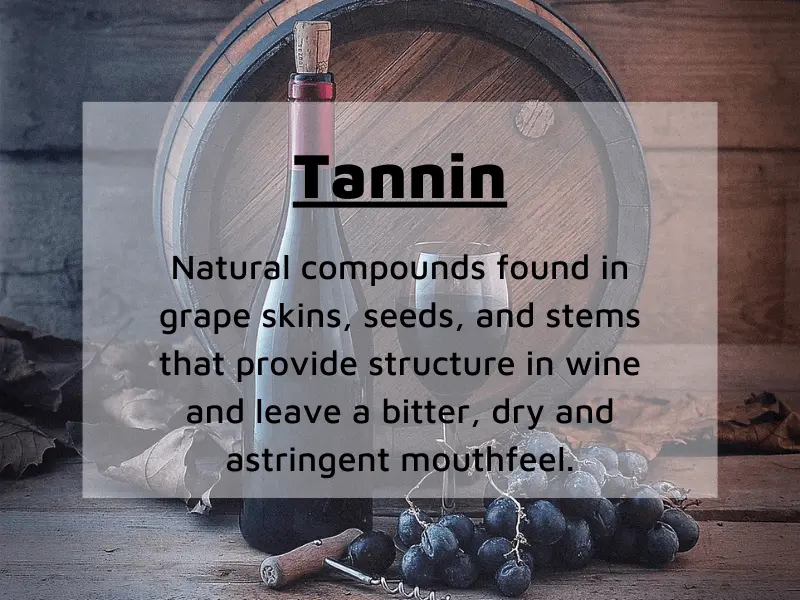
Wine terms starting with U
- Ullage: The space of air left in bottles and barrels when wine evaporates, which is a normal process of aging. The level of ullage can tell us more about the quality of older wine.
Wine terms starting with V
- Varietal: A wine made primarily from a single grape variety and usually named after that grape.
- Vegetal: When wine tastes and smells like vegetables.
- Veneto: An Italian wine region.
- Viniculture: The process of grape growing for winemaking.
- Vinification: Winemaking process.
- Vinology: Study of wines and winemaking.
- Vin Santo: Tuscan dessert wine.
- Vintage variation: The difference in taste in wines from different years, which is usually based on the weather’s influence on the grapes.
- Vintage: The year in which the grapes were harvested for the wine.
- Viognier: A white grape variety.
- Viticulture: The science of growing vines and wine grapes.
- Vitis Vinifera: Wine species that most of the wine is made of.
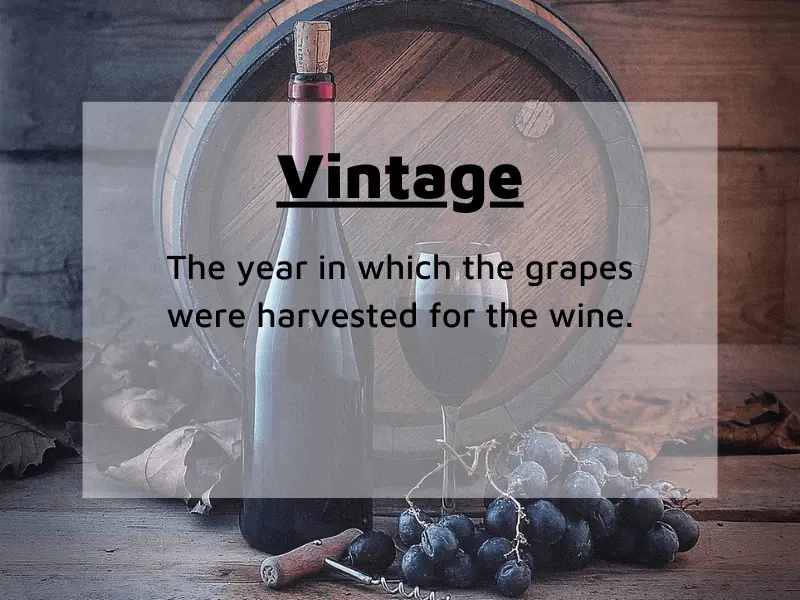
Wine terms starting with W
- Weight: How thick the wine feels.
- White Wine: Wine that is made from grape juice, that wasn’t fermented together with grape skin.
- Wine: Fermented grape juice.
- Wine glass: A glass designed for tasting wine.
- Wine tasting: How flavors in wine are perceived by sight, smell, and taste.
- Wine Pairing: Combining food with wine to create a great culinary experience.
Wine terms starting with Y
- Yeast: A microorganism that transforms grape juice into wine.
- Yeast nutrient: A supplement that provides necessary nutrients for yeast during fermentation, usually nitrogen and vitamins.
- Yeast strain: Different types of yeast are used for fermentation. Some strains are identified for a particular wine, which means they contribute to the flavor.
- Yield: How much a vineyard produced.
